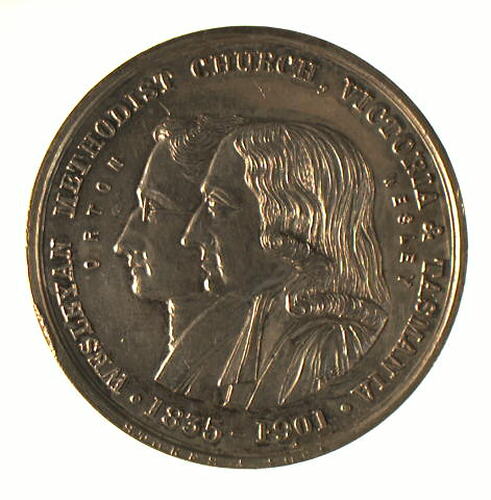John Wesley (1703-1791) was an ordained minister of the Church of England and a graduate of Oxford University. He and his brother Charles formed themselves into what was also called 'The Holy Club', and because they lived by 'method', the name Methodist was given to them. In May 1738, at a room in Aldersgate Street in London, Wesley 'felt his heart strangely warmed' by the assurance of faith for his personal salvation. As a result of the conversion of Wesley he and his brother founded the major eighteenth century spiritual awakening in England. The Wesleyan revival soon spread from England to America, where churches were established, conferences formed and extraordinary growth in spiritual and numerical strength occurred.
Methodism stressed evangelism and a closer association with God. Later it developed along denominational lines, first in the USA (1784, the Methodist Episcopal Church) and then in England in 1795 (or 1797, according to some sources), when under the leadership of Alexander Kilham the Methodist New Connection was formed. In the first half of the nineteenth century further break-aways led to the formation of the Primitive Methodists in 1807 led by Hugh Bourne and William Clowes, the Bible Christians in 1815, the Protestant Methodists in Leeds in 1827 and the Wesleyan Methodist Association in 1836. In the United States the Wesleyan Methodist Church developed independently in 1843 at Utica, New York, taking a stand against the slavery that was accepted by the mainstream Methodist Episcopal Church.
A final disruption in Britain came in 1849 when some church members determined to reform Wesleyan Methodism. These became known as Wesleyan Reformers, and although unsuccessful, eventually joined forces with the Protestant Methodists and the Wesleyan Methodist Association in 1857 to constitute the United Methodist Free Churches. Not all the reformers joined this united church, but formed another under the title Wesleyan Reform Union.
In Australia the arrival of Reverend Samuel Leigh on August 10 1815 marked the beginning of an organised Methodist Church in Australia. Leigh was referred to as a 'Wesleyan minister'. The governor quickly wrote to the British government that although Leigh's conduct was examplary, they only wanted Church of England ministers in the future. However, the government did grant Leigh land for a chapel in Macquarie Street, Sydney. It was completed in 1819. By the 1820s further groups of Methodists were active, with Sunday schools, a Bible society and support for missions to Polynesia. By 1836, however, British Methodism was disillusioned with the work in the Colony and the heavy demands that it placed on their resources for limited returns.
In 1855 the British conference granted autonomy to a separate body comprising churches in colonies in Australia, New Zealand and Polynesia.
In 1902 the various off-shoots of Methodism in Australia united to form the Methodist Church of Australasia. In 1977 the church became part of the Uniting Church.
In Australia during World War II many Christians became concerned about the spiritual needs of the Australian people and prayed for an awakening such as that which Wesley had brought about in England two centuries before. The Rev. Kingsley Ridgway encountered an American Wesleyan serviceman who inspired him to pursue contact with the Wesleyan Methodist Church of America. After the literature was studied, an invitation was extended to the movement to open work in Australia. A handful of people attended the early services, and an Inaugural Conference was held in 1947. Rev. Kingsley Ridgway served as the first President. The same year property was purchased in Glenroy, Victoria, and the Bible College program commenced.
The initial growth of the Wesleyan Church was slow in Australia, however, but it gradually expanded in the southern states in the immediate post-war period. Pastors' need to support their families with secular employment while caring for a church was a particular source of pressure which greatly hindered the church's expansion. The early 1970s saw a major change as the Congregational, Presbyterian and Methodist Churches moved toward merger. Unlike the other two, the Methodist Church did not make any provision for those of its members who, in conscience, could not join the Uniting Church. This meant that a number of dedicated ministers and laymen joined the Wesleyan Methodist Church, giving the impetus for the establishment of nucleus groups in various centres across the country. Thus the network expanded, the financial base broadened, and with the addition of several pastors from North America, the work leapt forward in a most encouraging way. By 1985, the Wesleyan Methodist Church of Australia increased to 41 churches, including 21 in Queensland. In 2003 almost 100 Wesleyan Methodist Churches exist throughout the Australian states, with congregations representing a growing number of ethnic communities. Wesleyan Methodist Churches also operate in more than 40 other countries.
References:
Wesleyan Methodist Church, Australia, website http://www.wesleyan.org.au/about/history.html
John Owen Smith website http://www.johnowensmith.co.uk/histdate/methdist.htm
Hardgrave, D. (c.1988). For Such a Time: A History of the Wesleyan Methodist Church of Australia.
More Information
-
Keywords
-
Localities
-
Authors
-
Article types
